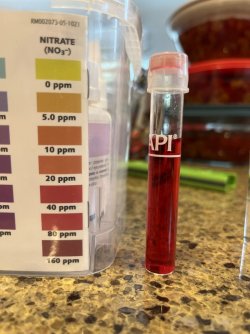Familyfishny
Fish Fanatic
Hi folks,
My sister-in-law had a major die-off in her tank a few days ago. She decided to close down her tank, and gave me her surviving two fish. These are two fairly old bronze cories, a mated pair. She brought them over in a tiny tank for quarantine, in their own tank water. She had just done a 30% change (which triggered the die-off), and thought it would be best not to shock them any further. Good thing, because here’s what the nitrate test looks like. I just did a 10% water change before testing; I’m afraid to do anything more now, because I don’t want to shock them too much. Do you think 10% water changes for the next several days would be best, or do I need to do a bigger water change right away? I’ve never heard of nitrates this high. Their tank must’ve been like this for a long time. I don’t know if they’ve acclimated and clean water would kill them, or if they’re at death’s door and need clean water asap. Any advice would be most welcome.
Stats:
2.5 gal (I know it’s too small, it’s just until I can put them in my 37gal), substrate and cave rocks from their home tank.
Ammonia: 0
Nitrite: 0
Nitrate: somewhere betweeen 50 and 140? They all look crimson on the test strip key
My sister-in-law had a major die-off in her tank a few days ago. She decided to close down her tank, and gave me her surviving two fish. These are two fairly old bronze cories, a mated pair. She brought them over in a tiny tank for quarantine, in their own tank water. She had just done a 30% change (which triggered the die-off), and thought it would be best not to shock them any further. Good thing, because here’s what the nitrate test looks like. I just did a 10% water change before testing; I’m afraid to do anything more now, because I don’t want to shock them too much. Do you think 10% water changes for the next several days would be best, or do I need to do a bigger water change right away? I’ve never heard of nitrates this high. Their tank must’ve been like this for a long time. I don’t know if they’ve acclimated and clean water would kill them, or if they’re at death’s door and need clean water asap. Any advice would be most welcome.
Stats:
2.5 gal (I know it’s too small, it’s just until I can put them in my 37gal), substrate and cave rocks from their home tank.
Ammonia: 0
Nitrite: 0
Nitrate: somewhere betweeen 50 and 140? They all look crimson on the test strip key




